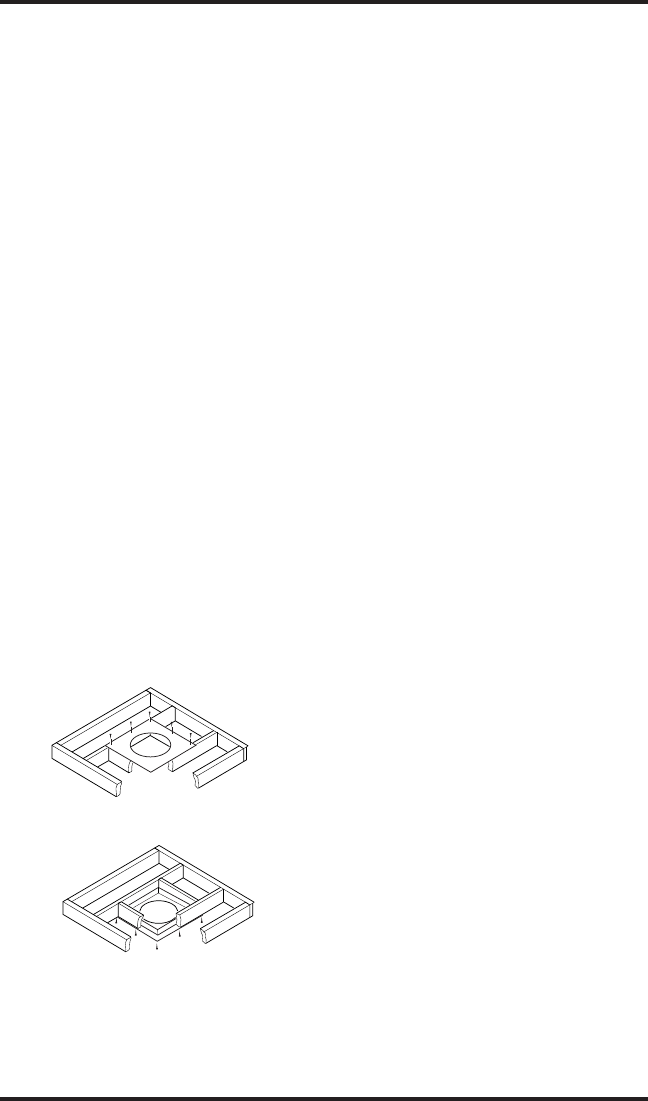Special offers from our partners!

Find Replacement BBQ Parts for 20,308 Models. Repair your BBQ today.

www.desatech.com
116035-01E 17
1.
Cut a 10
3
/
4
" square hole in the ceiling using
the locating hole as a center point. The opening
should be framed to 10
3
/
4
" x 10
3
/
4
" (273 mm x
273 mm) inside dimensions, as shown in Figure
12 on page 11 using framing lumber the same
size as the ceiling joists. If the area above the ceil-
ing is an insulated ceiling or a room, nail restop
from the top side. This prevents loose insulation
from falling into the required clearance space.
Otherwise, install restop below the framed hole.
The restop should be installed with no less than
three nails per side (see Figure 27).
2. Assemble the desired lengths of pipe and
elbows necessary to reach from the replace
ue up through the restop. Be sure all pipe
and elbow connections are fully twist-locked
(see Figure 11, page 10).
3. Cut a hole in the roof using the locating hole
as a center point. (Cover any exposed open
vent pipes before cutting hole in roof.) The
10
3
/
4
" x 10
3
/
4
" hole must be measured on
the horizontal; actual length may be larger
depending on the pitch of the roof. There
must be a 1" clearance from the vent pipe to
combustible materials. Frame the opening as
shown in Figure 12, page 11.
VENTING INSTALLATION
INSTRUCTIONS
Continued
Figure 27 - Installing Firestop
If area above is not a room, install restop
below framed hole.
If area above is a room or insulated area,
install restop above framed hole.
4. Connect a section of pipe and extend up
through the hole.
Note: If an offset is needed to avoid obstruc-
tions, you must support the vent pipe every
3 feet. Use wall straps for this purpose (see
Figure 26, page 16). Whenever possible, use
45° elbows instead of 90° elbows. The 45°
elbow offers less restriction to the ow of the
ue gases and intake air.
5. Place the ashing over the pipe section(s)
extending through the roof. Secure the base of
the ashing to the roof and framing with roof-
ing nails. Be sure roong material overlaps the
top edge of the ashing as shown in Figure 26,
page 16. There must be a 1" clearance from
the vent pipe to combustible materials.
6. Continue to add pipe sections until the height
of the vent cap meets the minimum building
code requirements described in Figure 10 on
page 8. Note: You must increase vent height
for steep roof pitches. Nearby trees, adjoining
rooines, steep pitched roofs and other similar
factors may cause poor draft or down-drafting
in high winds. Increasing the vent height may
solve this problem.
7. Twist-lock the vent cap onto the last section
of vent pipe.
Note: If the vent pipe passes through any occupied
areas above the rst oor, including storage spaces
and closets, you must enclose pipe. You may
frame and sheetrock the enclosure with standard
construction material. Make sure and meet the
minimum allowable clearances to combustibles.
Do not ll any of the required air spaces with
insulation.


















